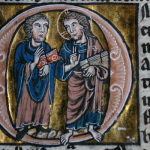San Francisco, Calif., Apr 17, 2015 / 04:13 am (CNA).- A group of Catholics promoting a full-page advertisement asking Pope Francis to remove Archbishop Salvatore Cordileone don’t represent San Francisco Catholics and misrepresent the facts, the archdiocese has said. “The advertisement is a misrepresentation of Catholic teaching, a misrepresentation of the nature of the (archdiocese’s) teacher contract, and a misrepresentation of the spirit of the archbishop,” the San Francisco archdiocese said April 15. “The greatest misrepresentation of all is that the signers presume to speak for ‘the Catholic community of San Francisco.’ They do not.” The ad also drew criticism from Eva Muntean, a local Catholic who is an organizer of the group SFCatholics.org. “It’s truly astonishing that a group of self-proclaimed ‘prominent Catholics’ has become so self-absorbed that they believe they can demand that the Holy Father remove an Archbishop because he refuses to sacrifice teaching Catholic values to children in our Catholic schools,” Muntean said April 16. “We stand with Archbishop Cordileone and support his leadership,” she said. The full-page ad in the San Francisco Chronicle presented an open letter signed by over 100 people, including business executives, business owners, prominent attorneys and charitable foundation leaders. Signers included parishioners and people with present or past connections to the archdiocese and area Catholic schools. Among the signers is Clint Reilly, a businessman and former political consultant whose firm Clinton Reilly Campaigns boasted past clients like U.S. Rep. Nancy Pelosi, U.S. Sens. Diane Feinstein and Barbara Boxer, former Los Angeles mayor Richard Riordan, and former San Francisco mayor Frank Jordan. Reilly is a past president of Catholic Charities CYO’s board of directors and has been a major donor to Catholic Charities. Another signer, Brian Cahill, is a former executive director of the local Catholic Charities affiliate. He has been an outspoken critic of Catholic teaching on homosexual relationships. He has also criticized several U.S. Catholic bishops, whom he claims are less pastoral than Pope Francis. Other signers include Tom Brady, Sr., an insurance firm principal who is the father of New England Patriots quarterback Tom Brady; and Charles Geschke, past chairman of the University of San Francisco board of trustees, who is the chairman of the tech company Adobe Systems. “Please provide us with a leader true to our values and your namesake,” the ad asked the Pope. “Please replace Archbishop Cordileone.” The ad accused the archbishop of fostering “division and intolerance.” It objected to the archbishop’s addition of an explanation of Catholic moral teaching to faculty and staff handbooks for the archdiocese’s four high schools. The ad claimed the explanations of Catholic teaching showed “absolute mean-spiritedness” that “sets a pastoral tone closer to persecution than evangelization.” They claimed a Catholic morality code would violate individual conscience and California labor law. The ad also objected to Archbishop Cordileone’s selection of a pastor at Star of the Sea Parish who decided only to have altar boys and not female altar servers. The ad claimed that the archbishop has “isolated himself from our community” and that he has a “single-issue agenda” that threatens the archdiocese. In response, the archdiocese said it has met with a “broad range of stakeholders” and “engaged in a constructive dialogue on all of the issues raised in this ad.” “We welcome the chance to continue that discussion,” the archdiocese said. Muntean charged that the ad is “a slur on a good and decent man who has devoted his life in service to others.” San Francisco Chronicle columnists Phillip Matier and Andrew Ross said that neither the Chronicle’s business department nor the ad sponsors would say how much the ad cost. “We’re told, however, that full-page ads typically run in the tens of thousands of dollars,” the columnists said April 16. Some high school students, teachers and parents have publicly protested the archbishop's proposals. But other money has also been connected to the controversy. Some opponents of Archbishop Cordileone have hired Sam Singer of the public relations firm Singer and Associates to back their cause. Singer has represented the oil giant Chevron for decades. He was hired by the directors of the Bay Area Rapid Transit District during a 2013 labor dispute with public transit unions. On Twitter, Singer published or re-tweeted over 40 tweets highlighting the anti-Cordileone ad. The voices of the city’s leaders are “loud and clear” that “Cordileone must go,” Singer said in an April 16 tweet. In a public post on his Facebook profile, Singer linked to a story about the ad, writing “the heat is on.” While a February report in the SF Weekly indicated that Singer had been hired due to controversy in the Catholic high schools, Singer later told the National Catholic Reporter he had been hired by alumni, parents and their supporters involved in the dispute over Star of the Sea Catholic School, a K-8 institution connected to the parish of the same name. On Feb. 18, Ash Wednesday, Singer said on the social media site Google+ that “everyone is praying that the Pope will remove the San Francisco Archbishop.” The campaign against the archbishop is intimidating some Catholics. A Catholic teacher who has worked at an archdiocesan high school for several years told CNA in March that the media campaign against Archbishop Cordileone “has caused fear among his supporters.” The controversies in the Archdiocese of San Francisco come after significant activist funding. One Archbishop Cordileone opponent is the group Faithful America, a partner of the Berkeley, Calif.-based Citizen Engagement Lab. The group was the recipient of a $75,000 Arcus Foundation grant in 2014 to “promote greater media visibility for Christians who denounce the abuse of religious-freedom arguments to oppose full equality for LGBT persons.” An early petition against the archbishop was created by Jim Fitzgerald, executive director of Call to Action, a decades-old dissenting Catholic group. The group’s “JustChurch” project specifically opposes morality clauses in Catholic schools. The group is part of the Equally Blessed Coalition, with the LGBT activist groups Dignity USA and New Ways Ministry. The coalition has received at least $200,000 from the Arcus Foundation to “counter the narrative of the Catholic Church” ahead of the Synod on the Family, according to grant listings on the foundation website. Archbishop Cordileone was Bishop of Oakland, Calif. from 2009 until 2012. He has served as the U.S. bishops’ conference’s ad hoc committee for the defense of marriage. He has also served on a governing body for Courage, a ministry for people with same-sex attraction who want to live a life consistent with Catholic faith and morals. Read more
















